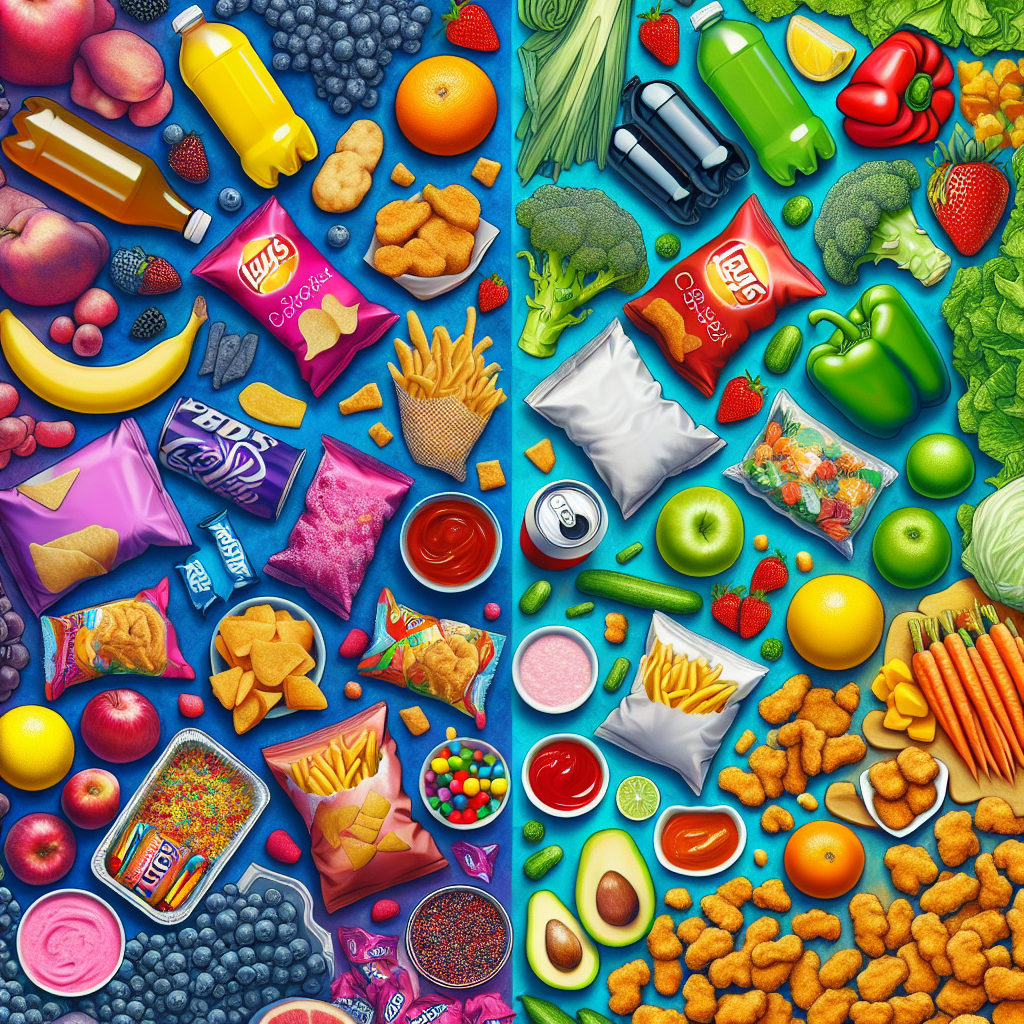Ultra-processed foods (UPFs) have become a significant concern among nutritionists due to their prevalence and potential health risks. These foods, which include items like chicken nuggets, packaged snacks, and sugary drinks, account for over half of the calories consumed in the UK, particularly among children and those in lower-income areas. Defined by their extensive industrial processing and the presence of numerous unrecognizable ingredients, UPFs are often high in fat, sugar, and salt. Their synthetic appearance and taste have made them a focal point for advocates of healthier eating, yet the scientific community remains divided on the exact health implications of these foods.
Recent research has indicated a correlation between UPF consumption and various health issues, such as obesity, heart disease, and even certain cancers. For instance, a large observational study in the United States found that individuals who consumed the most UPFs had a 10% higher risk of early death, even when accounting for body mass index and overall diet quality. However, establishing a direct causal relationship between UPFs and these health problems is challenging. While many studies suggest a link, they do not definitively prove that the processing of food is the root cause of health issues.
To truly understand the impact of UPFs on health, researchers propose conducting complex studies that compare individuals on high-UPF diets with those on low-UPF diets, ensuring both groups have similar calorie and nutrient intake. Such studies would require meticulous control over participants’ food consumption and lifestyle habits, making them logistically difficult and expensive. Additionally, funding for this type of research may be hard to secure due to potential conflicts of interest, as researchers may have preconceived notions about the outcomes they wish to demonstrate.
Another point of contention in the discussion about UPFs is the classification and understanding of what constitutes these foods. UPFs typically contain more than five ingredients, many of which are not found in a typical kitchen. This broad classification raises questions about whether all UPFs should be viewed equally, as some may have different effects on health than others. For example, while sugary cereals and low-fat yogurts are both categorized as UPFs, their nutritional profiles and health impacts may vary significantly.
The debate surrounding UPFs also highlights the broader issue of food accessibility and affordability. Many experts argue that vilifying UPFs can lead to feelings of guilt and confusion among consumers, particularly when healthier options can be significantly more expensive. For those on a tight budget, maintaining a diet free of UPFs may not be feasible. Ultimately, while the current evidence does not conclusively prove that UPFs are harmful, nutritionists generally advocate for a balanced diet rich in whole foods, fruits, and vegetables, regardless of the ongoing research into UPFs.
Original news source: Why we might never know the truth about ultra-processed foods (BBC)
🎧 Listen:
Slow
Normal
Fast
📖 Vocabulary:
| 1 | prevalence | The state of being widespread or common |
| 2 | implications | Possible effects or consequences of an action or decision |
| 3 | correlation | A mutual relationship or connection between two or more things |
| 4 | observational | Based on watching and recording events or behaviors |
| 5 | causal | Relating to or acting as a cause |
| 6 | meticulous | Showing great attention to detail; very careful and precise |
| 7 | logistically | In a way that involves detailed organization and planning |
| 8 | preconceived | Formed before having the evidence for its truth or usefulness |
| 9 | contention | Disagreement or argument about something important |
| 10 | constitutes | To be considered as or to make up something |
| 11 | vilifying | Criticizing or speaking ill of someone or something |
| 12 | feasible | Possible to do easily or conveniently |
| 13 | conclusively | In a way that leaves no doubt; decisively |
| 14 | advocate | To publicly recommend or support |
| 15 | accessibility | The quality of being easy to approach, reach, or use |
Group or Classroom Activities
Warm-up Activities:
– CHARADES
Instructions: Divide the class into small groups. Each group will take turns acting out different ultra-processed foods (e.g., chicken nuggets, sugary drinks) without speaking, while the other groups guess what they are. This will help students familiarize themselves with vocabulary and concepts related to UPFs in a fun way.
– OPINION SPECTRUM
Instructions: Create a line in the classroom labeled “Strongly Agree” to “Strongly Disagree.” Read various statements related to ultra-processed foods (e.g., “Ultra-processed foods should be banned,” “Healthier options should be more affordable”). Students will position themselves along the line based on their opinions and discuss their reasoning with their peers.
– MIND MAP
Instructions: In small groups, students will create a mind map on the topic of ultra-processed foods. They should include branches for definitions, examples, health implications, and societal impacts. This visual representation will help them organize their thoughts and deepen their understanding of the topic.
– HEADLINE CREATION
Instructions: Ask students to create catchy headlines for a news article about ultra-processed foods based on the information in the article. They should aim to capture the main issue and make it engaging for readers. Afterward, groups can share their headlines with the class.
– SPEED SUMMARIZING
Instructions: In pairs, students will take turns summarizing different sections of the article within one minute. One student will summarize while the other listens, then they will switch roles. This fast-paced activity will enhance their summarization skills and ensure they grasp the key points of the article.
🤔 Comprehension Questions:
1. What types of foods are classified as ultra-processed foods (UPFs) and why are they a concern among nutritionists?
2. According to recent research, what health issues have been correlated with the consumption of UPFs?
3. What challenges do researchers face in establishing a direct causal relationship between UPFs and health problems?
4. What type of studies do researchers propose to better understand the impact of UPFs on health?
5. How do the ingredients in UPFs typically differ from those found in a typical kitchen?
6. What arguments do experts make regarding the potential negative effects of vilifying UPFs on consumers?
7. In what ways do the nutritional profiles of different UPFs, such as sugary cereals and low-fat yogurts, vary?
8. What general dietary recommendations do nutritionists advocate for, regardless of the ongoing research into UPFs?
Go to answers ⇩
🎧✍️ Listen and Fill in the Gaps:
Ultra-processed foods (UPFs) have (1)______ a significant concern among nutritionists due to their prevalence and potential health risks. These foods, which include items like chicken nuggets, packaged snacks, and sugary drinks, account for over half of the calories consumed in the UK, particularly among (2)______ and those in lower-income areas. Defined by their extensive industrial processing and the presence of numerous unrecognizable ingredients, UPFs are often high in fat, sugar, and salt. Their (3)______ appearance and taste have made them a focal point for advocates of healthier eating, yet the (4)______ community remains divided on the exact health implications of these foods.
Recent research has indicated a correlation between UPF consumption and various health (5)______, such as obesity, heart disease, and even certain cancers. For instance, a large observational study in the United (6)______ found that individuals who consumed the most UPFs had a 10% higher risk of early death, even when accounting for body mass index and overall diet quality. However, establishing a direct causal relationship between UPFs and these health problems is challenging. While many studies suggest a link, they do not definitively prove that the processing of food is the root cause of health issues.
To truly understand the impact of UPFs on health, researchers propose conducting complex studies that compare individuals on high-UPF (7)______ with those on low-UPF diets, ensuring both (8)______ have similar calorie and (9)______ intake. Such studies would require meticulous control over participants’ food consumption and lifestyle habits, making them logistically difficult and expensive. Additionally, funding for this type of research may be hard to secure due to (10)______ conflicts of interest, as researchers may have preconceived notions about the outcomes they wish to demonstrate.
Another point of contention in the discussion about UPFs is the classification and understanding of what constitutes these foods. UPFs typically contain more than five (11)______, many of which are not found in a typical kitchen. This (12)______ classification raises questions about whether all UPFs should be viewed equally, as some may have different effects on health than others. For example, while sugary cereals and low-fat yogurts are both categorized as UPFs, their nutritional profiles and health impacts may vary significantly.
The (13)______ surrounding UPFs also highlights the (14)______ issue of food accessibility and affordability. Many experts argue that vilifying UPFs can lead to feelings of guilt and confusion among consumers, particularly when healthier options can be significantly more expensive. For those on a tight budget, maintaining a diet free of UPFs may not be feasible. Ultimately, while the current (15)______ does not conclusively prove that UPFs are harmful, nutritionists generally advocate for a balanced diet rich in whole foods, fruits, and vegetables, regardless of the (16)______ research into UPFs.
Go to answers ⇩
💬 Discussion Questions:
Students can ask a partner these questions, or discuss them as a group.
1. What is your opinion on the impact of ultra-processed foods on society’s health?
2. How would you feel if you had to eliminate all ultra-processed foods from your diet?
3. Do you think it is possible to maintain a healthy diet without consuming any ultra-processed foods? Why or why not?
4. What is a common ultra-processed food in your country, and how do you think it affects people’s eating habits?
5. How do you feel about the marketing of ultra-processed foods, especially towards children?
6. Do you think that the convenience of ultra-processed foods outweighs their potential health risks? Why or why not?
7. What is your personal experience with cooking and eating whole foods versus ultra-processed foods?
8. How would you feel if a new study definitively proved that ultra-processed foods are harmful to health?
9. Do you think that the government should regulate the production and sale of ultra-processed foods? Why or why not?
10. What is a healthy alternative to an ultra-processed food that you enjoy?
11. How do you think socio-economic status impacts people’s choices between ultra-processed and whole foods?
12. Do you believe that education about nutrition can change people’s eating habits regarding ultra-processed foods? Why or why not?
13. What is your perspective on the role of food companies in promoting healthier eating habits?
14. How would you feel if you were in a situation where you could only afford ultra-processed foods?
15. Do you think that the classification of foods into categories like “ultra-processed” is helpful or misleading? Why?
Individual Activities
📖💭 Vocabulary Meanings:
Match each word to its meaning.
Words:
1. prevalence
2. implications
3. correlation
4. observational
5. causal
6. meticulous
7. logistically
8. preconceived
9. contention
10. constitutes
11. vilifying
12. feasible
13. conclusively
14. advocate
15. accessibility
Meanings:
(A) Criticizing or speaking ill of someone or something
(B) Formed before having the evidence for its truth or usefulness
(C) In a way that involves detailed organization and planning
(D) In a way that leaves no doubt; decisively
(E) Relating to or acting as a cause
(F) To publicly recommend or support
(G) Showing great attention to detail; very careful and precise
(H) Possible effects or consequences of an action or decision
(I) A mutual relationship or connection between two or more things
(J) The quality of being easy to approach, reach, or use
(K) Possible to do easily or conveniently
(L) To be considered as or to make up something
(M) Disagreement or argument about something important
(N) Based on watching and recording events or behaviors
(O) The state of being widespread or common
Go to answers ⇩
🔡 Multiple Choice Questions:
1. What are ultra-processed foods (UPFs) primarily characterized by?
(a) High levels of natural ingredients
(b) Low calorie content
(c) Minimal processing
(d) Extensive industrial processing and unrecognizable ingredients
2. Which demographic is particularly affected by the consumption of UPFs in the UK?
(a) Elderly individuals
(b) Children and those in lower-income areas
(c) Athletes
(d) High-income families
3. What health issues have been correlated with UPF consumption according to recent research?
(a) Obesity, heart disease, and certain cancers
(b) Diabetes and hypertension
(c) Allergies and asthma
(d) Osteoporosis and arthritis
4. What is a major challenge in establishing a direct causal relationship between UPFs and health problems?
(a) Lack of interest from the scientific community
(b) Insufficient data on UPF consumption
(c) Difficulty in conducting controlled studies
(d) Limited access to UPFs
5. How many ingredients do UPFs typically contain?
(a) More than five ingredients
(b) Fewer than three ingredients
(c) Exactly five ingredients
(d) Only natural ingredients
6. What do experts warn about vilifying UPFs?
(a) It will improve public health awareness
(b) It will reduce their consumption
(c) It can lead to guilt and confusion among consumers
(d) It will make healthier options more accessible
7. What do nutritionists generally advocate for despite ongoing research into UPFs?
(a) A diet exclusively free of processed foods
(b) Increased consumption of sugary snacks
(c) A focus on high-protein diets
(d) A balanced diet rich in whole foods, fruits, and vegetables
8. Why might funding for research on UPFs be difficult to secure?
(a) Lack of interest from the public
(b) Potential conflicts of interest among researchers
(c) Government regulations on food research
(d) High costs of conducting studies on whole foods
Go to answers ⇩
🕵️ True or False Questions:
1. Establishing an indirect causal relationship between UPFs and health problems is straightforward due to the simplicity of dietary factors.
2. A small observational study in the United States found that individuals who consumed the most UPFs had a 10% lower risk of early death.
3. UPFs are characterized by their minimal industrial processing and the absence of numerous unrecognizable ingredients.
4. Nutritionists generally advocate for a balanced diet rich in whole foods, fruits, and vegetables, regardless of the ongoing research into UPFs.
5. UPFs typically contain less than five ingredients, many of which are commonly found in a typical kitchen.
6. The debate surrounding UPFs raises concerns about food accessibility and affordability, particularly for those on tight budgets.
7. Recent research has indicated a correlation between UPF consumption and various health issues, including obesity and heart disease.
8. Ultra-processed foods (UPFs) account for over half of the calories consumed in the UK, particularly among children and those in lower-income areas.
Go to answers ⇩
📝 Write a Summary:
Write a summary of this news article in two sentences.
Check your writing now with the best free AI for English writing!
Writing Questions:
Answer the following questions. Write as much as you can for each answer.
Check your answers with our free English writing assistant!
1. What are ultra-processed foods (UPFs) and why are they a concern among nutritionists?
2. What health issues have been correlated with the consumption of UPFs according to recent research?
3. What challenges do researchers face when trying to establish a causal relationship between UPFs and health problems?
4. How does the classification of UPFs complicate the understanding of their health impacts?
5. In what ways does the discussion about UPFs relate to issues of food accessibility and affordability?
✅ Answers
🤔✅ Comprehension Question Answers:
1. What types of foods are classified as ultra-processed foods (UPFs) and why are they a concern among nutritionists?
Ultra-processed foods (UPFs) include items like chicken nuggets, packaged snacks, and sugary drinks. They are a concern among nutritionists due to their prevalence and potential health risks, as they account for over half of the calories consumed in the UK, particularly among children and those in lower-income areas.
2. According to recent research, what health issues have been correlated with the consumption of UPFs?
Recent research has indicated a correlation between UPF consumption and various health issues, such as obesity, heart disease, and even certain cancers.
3. What challenges do researchers face in establishing a direct causal relationship between UPFs and health problems?
Establishing a direct causal relationship is challenging because while many studies suggest a link between UPFs and health problems, they do not definitively prove that the processing of food is the root cause of these issues.
4. What type of studies do researchers propose to better understand the impact of UPFs on health?
Researchers propose conducting complex studies that compare individuals on high-UPF diets with those on low-UPF diets, ensuring both groups have similar calorie and nutrient intake.
5. How do the ingredients in UPFs typically differ from those found in a typical kitchen?
UPFs typically contain more than five ingredients, many of which are not found in a typical kitchen, making them less recognizable and more industrially processed.
6. What arguments do experts make regarding the potential negative effects of vilifying UPFs on consumers?
Experts argue that vilifying UPFs can lead to feelings of guilt and confusion among consumers, especially when healthier options can be significantly more expensive, making it difficult for those on a tight budget to maintain a diet free of UPFs.
7. In what ways do the nutritional profiles of different UPFs, such as sugary cereals and low-fat yogurts, vary?
While both sugary cereals and low-fat yogurts are categorized as UPFs, their nutritional profiles and health impacts may vary significantly, indicating that not all UPFs should be viewed equally.
8. What general dietary recommendations do nutritionists advocate for, regardless of the ongoing research into UPFs?
Nutritionists generally advocate for a balanced diet rich in whole foods, fruits, and vegetables, regardless of the ongoing research into UPFs.
Go back to questions ⇧
🎧✍️✅ Listen and Fill in the Gaps Answers:
(1) become
(2) children
(3) synthetic
(4) scientific
(5) issues
(6) States
(7) diets
(8) groups
(9) nutrient
(10) potential
(11) ingredients
(12) broad
(13) debate
(14) broader
(15) evidence
(16) ongoing
Go back to questions ⇧
📖💭✅ Vocabulary Meanings Answers:
1. prevalence
Answer: (O) The state of being widespread or common
2. implications
Answer: (H) Possible effects or consequences of an action or decision
3. correlation
Answer: (I) A mutual relationship or connection between two or more things
4. observational
Answer: (N) Based on watching and recording events or behaviors
5. causal
Answer: (E) Relating to or acting as a cause
6. meticulous
Answer: (G) Showing great attention to detail; very careful and precise
7. logistically
Answer: (C) In a way that involves detailed organization and planning
8. preconceived
Answer: (B) Formed before having the evidence for its truth or usefulness
9. contention
Answer: (M) Disagreement or argument about something important
10. constitutes
Answer: (L) To be considered as or to make up something
11. vilifying
Answer: (A) Criticizing or speaking ill of someone or something
12. feasible
Answer: (K) Possible to do easily or conveniently
13. conclusively
Answer: (D) In a way that leaves no doubt; decisively
14. advocate
Answer: (F) To publicly recommend or support
15. accessibility
Answer: (J) The quality of being easy to approach, reach, or use
Go back to questions ⇧
🔡✅ Multiple Choice Answers:
1. What are ultra-processed foods (UPFs) primarily characterized by?
Answer: (d) Extensive industrial processing and unrecognizable ingredients
2. Which demographic is particularly affected by the consumption of UPFs in the UK?
Answer: (b) Children and those in lower-income areas
3. What health issues have been correlated with UPF consumption according to recent research?
Answer: (a) Obesity, heart disease, and certain cancers
4. What is a major challenge in establishing a direct causal relationship between UPFs and health problems?
Answer: (c) Difficulty in conducting controlled studies
5. How many ingredients do UPFs typically contain?
Answer: (a) More than five ingredients
6. What do experts warn about vilifying UPFs?
Answer: (c) It can lead to guilt and confusion among consumers
7. What do nutritionists generally advocate for despite ongoing research into UPFs?
Answer: (d) A balanced diet rich in whole foods, fruits, and vegetables
8. Why might funding for research on UPFs be difficult to secure?
Answer: (b) Potential conflicts of interest among researchers
Go back to questions ⇧
🕵️✅ True or False Answers:
1. Establishing an indirect causal relationship between UPFs and health problems is straightforward due to the simplicity of dietary factors. (Answer: False)
2. A small observational study in the United States found that individuals who consumed the most UPFs had a 10% lower risk of early death. (Answer: False)
3. UPFs are characterized by their minimal industrial processing and the absence of numerous unrecognizable ingredients. (Answer: False)
4. Nutritionists generally advocate for a balanced diet rich in whole foods, fruits, and vegetables, regardless of the ongoing research into UPFs. (Answer: True)
5. UPFs typically contain less than five ingredients, many of which are commonly found in a typical kitchen. (Answer: False)
6. The debate surrounding UPFs raises concerns about food accessibility and affordability, particularly for those on tight budgets. (Answer: True)
7. Recent research has indicated a correlation between UPF consumption and various health issues, including obesity and heart disease. (Answer: True)
8. Ultra-processed foods (UPFs) account for over half of the calories consumed in the UK, particularly among children and those in lower-income areas. (Answer: True)
Go back to questions ⇧













